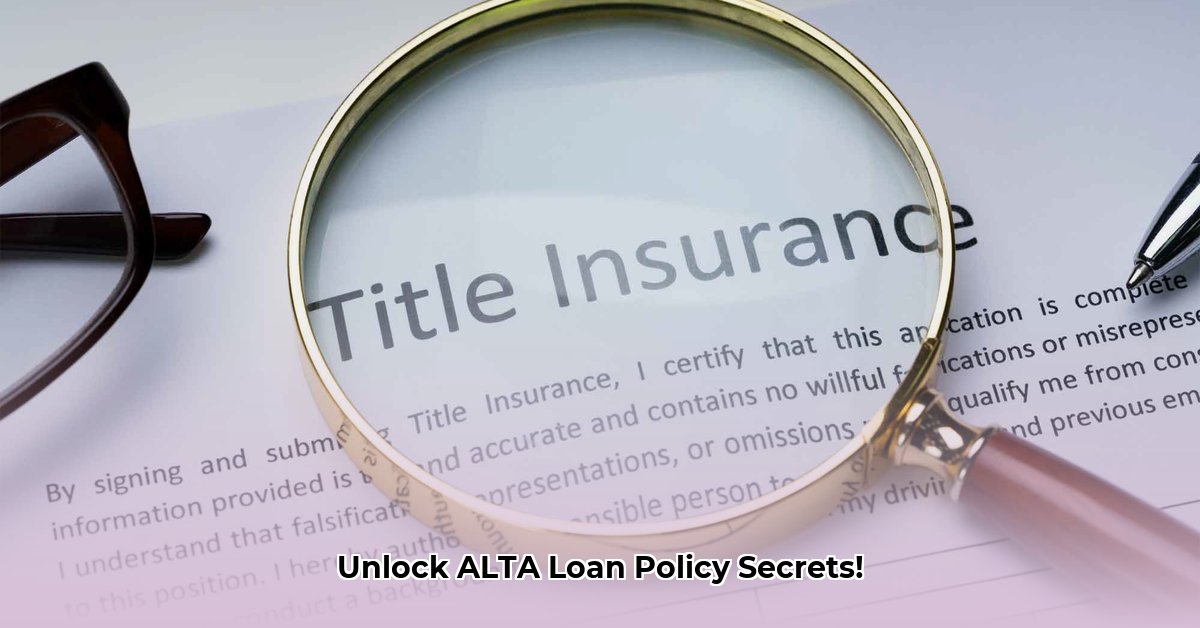
Understanding ALTA Loan Policy Forms in Legal Tech Development
ALTA loan policy forms are industry-standard documents in real estate transactions. For legal tech developers, understanding and correctly implementing these forms is crucial for building compliant and efficient software. This guide provides a step-by-step approach to navigating the complexities of ALTA forms and integrating them into your legal tech solutions. Ignoring these crucial documents can lead to significant legal and financial ramifications. What are the biggest challenges you face when integrating ALTA forms into your legal tech?
Decoding ALTA Loan Policy Forms: Addressing Key Challenges
The primary challenges in working with ALTA loan policy forms include access to the most current versions and handling the inconsistencies that can arise from variations and customizations. Restricted access for non-ALTA members can hinder development. Even with standardized forms, real-world transactions often involve adaptations. Consequently, your software needs flexibility to accommodate both standard and customized variations.
Accessing ALTA Loan Policy Forms: Strategies for Legal Tech Developers
Accessing ALTA forms depends on your membership status. ALTA members enjoy full access. However, non-members must explore alternative strategies:
Collaboration: Partner with title companies or lawyers who are ALTA members to gain access to forms or guidance. Remember to carefully consider legal implications when handling non-publicly available information. Did you know that unauthorized access to these forms can lead to serious legal repercussions?
Public Resources: Leverage publicly available summaries and explanations as a starting point, particularly useful for Minimum Viable Product (MVP) development. This approach, while limiting, allows you to establish a functional foundation.
Building Compliant Legal Tech: A Practical, Step-by-Step Guide
Integrating ALTA loan policy forms effectively requires careful planning. Follow these steps to ensure compliance and efficiency:
Efficient Data Extraction: Your software must efficiently and accurately extract information from ALTA forms. This necessitates the ability to handle various formats and potential inconsistencies. Consider whether to utilize existing systems or develop customized solutions.
Robust Error Handling: Implement comprehensive error handling to mitigate the risks associated with inconsistencies in the forms. Redundancy and safeguards are essential to prevent cascading failures and ensure the accuracy of your system. Can your current system handle unexpected inconsistencies gracefully, thereby minimizing errors in output?
Essential Legal Consultation: Obtain legal counsel to ensure compliance with all relevant laws and regulations. Remember, legal requirements vary by jurisdiction. What is your plan to address ongoing legal updates and regulatory changes?
Strategic Planning for Legal Tech Integration: Short-Term and Long-Term Goals
Different stakeholders have varying perspectives on integrating ALTA forms:
| Stakeholder | Short-Term Goals | Long-Term Vision |
|---|---|---|
| Legal Tech Startups | Focus on a few specific form types. Build a functional MVP. Prioritize accurate data reading. | Build strategic partnerships. Develop AI-powered contract analysis tools. Secure robust legal support. |
| Established Firms | Integrate ALTA form processing into existing platforms. | Invest in R&D for automated compliance systems. Explore API integration where possible. |
Risk Assessment and Mitigation: Identifying and Addressing Potential Issues
Proactive risk assessment is critical:
| Risk | Likelihood of Occurrence | Potential Impact | Mitigation Strategy |
|---|---|---|---|
| Legal Non-Compliance | High | Extremely Serious | Thorough legal review, regular monitoring, updates |
| Software Errors | Moderate | Serious | Comprehensive testing, built-in safeguards |
| Market Demand Issues | Moderate | Moderate | Focus on user needs, agile adaptation |
Legal Access and Utilization of ALTA Policy Forms
Successfully integrating ALTA policy forms requires understanding and adhering to their licensing system:
Copyright Compliance: ALTA policy forms are copyrighted. Using them necessitates a valid license.
Licensing Fees: Fees vary based on annual revenue and policy volume. Non-members require individual licenses, while ALTA membership includes licensing.
Penalty for Non-Compliance: Late or missed payments incur penalties. Staying current with payments is crucial.
Defining the Issuing Agent: Understanding your status as an "issuing agent" is critical for determining your licensing obligations.
By adhering to these guidelines and employing effective risk mitigation strategies, developers can successfully integrate ALTA policy forms into their systems. Improper handling of these forms not only risks fines but also undermines the integrity of real estate transactions. Are you fully confident in your understanding and implementation of ALTA's licensing requirements?